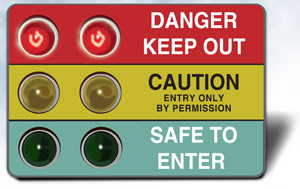To interlock or not to interlock?
Ken Barat, Laser Safety Officer, Lawrence Berkeley National Laboratory
Thinking about installing a laser safety interlock on the door to your Class 4 laser lab? If so, you might want to give that decision some careful consideration. A safety interlock that stops the laser or blocks the laser beam (with a shutter) if the lab door is opened is only one of three solutions for Class 4 controlled areas described in ANSI Z136.1, ”Safe Use of Lasers.” The other two are a door interlock that allows entry by authorized personnel without interrupting the laser (called a defeatable interlock) and procedural controls such as an external indication that a laser is operating in the lab, together with proper training of all personnel about the precautions necessary when entering the room.

If the door is interlocked and the red light is on, opening the door shuts down the laser inside — possibly ruining the experiment being conducted.
As an interesting aside, I will note that ANSI Z136.3, “Safe Use of Lasers in Health Care Facilities,” mentions only the last option, presumably to allow for the more erratic flow of personnel through Class 4 control areas. In that case, the best approach is to train everybody.
A safety interlock on the lab door certainly has its place in the laser safety arsenal, but it should not always be the automatic first choice. Only a few commercial door interlocks are on the market, and the majority used today are homemade systems put together at considerable expense. The cost can range from $2,000 to $40,000 per room, even when there is only one door to the room. Moreover, once you have installed the interlock, it becomes a safety system that requires written procedures, periodic testing and isolation from other systems.
It is not hard to imagine situations where a simpler solution would be better than a door interlock. In many cases, merely providing a lock that cannot be opened by unauthorized people could ensure adequate safety. In other cases, where it is practical to provide training to everybody with access to the lab, a simple warning light outside the lab door is sufficient. And in some Class 4 areas, all beams are contained by enclosures, fibers or beam blocks. In these cases, interlocks provide no additional value.
Users with interlocks describe them as an operational annoyance, and they must be compatible with fire emergency exit codes. In conclusion, safety interlocks on lab doors can be a psychological comfort to managers, but they often provide little if any increased safety.
Meet the author
Ken Barat is a laser safety officer at Lawrence Berkeley National Laboratory in California and has held the same position with the National Ignition Facility Directorate at Lawrence Livermore National Laboratory; e-mail: [email protected].